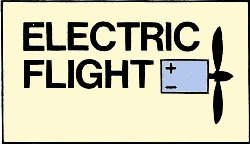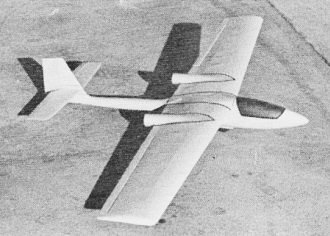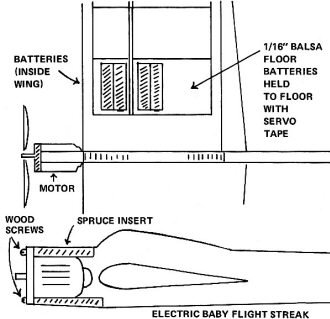|
Things were all so simple then; time
has rewritten every line - to paraphrase a popular song from the mid-1970's. That was
the era when this 1975 issue of American Aircraft Modeler
magazine ran the Electric Flight Action column by Mitch Poling. Having just
entered into the radio control (R/C) phase of aeromodeling at the time, I was
not too overly interested in electric flight since my prior experience had been
with glow fuel powered control line models. Electric propulsion systems were
overly heavy, overly large, and underly (sic) powerful. Brushed motors with
standard magnets, and usually without ball bearings on the shaft lacked the
power of today's brushless motors. Nickel cadmium (NiCad) batteries have about a
quarter the energy storage density as lithium types (Li-Ion or Li-Po, so
combined with the low efficiency of the motors, flight times were very short. My
first experience with an R/C e-powered model was a
Great Plane Spectra
sailplane, which was a powered version of their
2-Meter Spirit glider. a
while later I tried a Carl Goldberg
Mirage 550 e-powered model. Both were plagued with brush and commutator
problems. All of those issues have been solved with modern brushless motors and
Li-Po batteries - which have their own issues, primarily cost and fire hazards.
I wonder whether modern material and methods could produce a much improved
brushed motor with a simple (and less expensive) ESC, using NiMH batteries that
would provide acceptable flight characteristics?
Electric Flight Action
 Mitch Poling on Electric Flight Mitch Poling on Electric Flight
Electric Control Line: Until recently, electric control line meant a battery
at the center of the circle, with current running through the flying wires to the
plane. However, the resistance in the wires is more than that in the motor, and
the lines absorb the lion's share of the power. An alternative is to put the batteries
in the plane; with lightweight, half-ampere hour, nickel-cadmium cells, this is
quite practical. For the past month, I have been flying an electric Baby Flite Streak
(Top Flite Models) with the batteries in the wing. It is fun, and works well.
Ed Sweeney flew the plane indoors at the Anaheim hobby show and drew a large
crowd. It is ideal for indoor flying. The sketch shows the installation of the batteries
and motor. Bob Hanson (Hobby Manor, Davis, Calif.) built the plane stock except
for the motor cutout in the nose. Four GE Permacells were installed in the wing,
and a Plymouth washer motor, wound with 20 turns of No. 24 magnet wire per two poles,
was installed. The motor turns a 5 1/4 x 3 Top Flite prop at 10,500 rpm, about the
power of a Pee Wee 020. Flying weight is 8.5 oz., and flying is done on 20' dacron
lines. A six-volt motorcycle battery charges the unit in 10 min., for about three
min. of flight.
I t will do up to 70° wing overs, but does not have enough power to pull through
a loop or a vertical wing over. It is good as a beginner's airplane, since full
up elevator causes it to mush around the circle, instead of whipping overhead in
the usual beginner's crash. The motor is turned on by clipping the positive lead
to the terminal made for it on the motor. The clip is part of the installation in
the washer unit, and can be obtained with the motor.
Charging is done by clipping the negative charging battery lead to the negative
terminal on the motor, and the positive lead to the positive lead for the motor
(be sure it is disconnected before doing so). Alligator clips and three feet of
extension cord wire were used for the charging cord.
Astro Flight Questions and Answers: Continuing from recent columns, here are
commonly asked questions from the Astro Flight files, and Roland Boucher's answers.

Electra 225, a twin Astro-25 powered pattern design by the Boucher
brothers.

Electric flight equipment installation.
Question: Is electric power suited to beginners in RC flying?
Answer: Yes, but don't expect it to be easier than gas just because it is easier
to start the motor. Electric power is heavier, so building an electric plane requires
a reasonable amount of care to keep the weight down. If a kit is modified to electric
power, shorten the nose moment to preserve balance. A properly built electric plane
could make a good club plane, since the instructor could turn the motor off before
giving the stick to the novice. The model can be set for a gentle glide, with the
motor off, so that the beginner can learn the basic maneuvers.
(Columnist's comment: The new Astro Pup should be ideal for beginners using two
channels and the popular 049 trainers.)
Question: Are any competition classes particularly suited to electric flying?
Answer: Yes, scale airplanes are a natural for electric power, and their usually
short nose moments pose no problems. The new powered sailplane classes could use
electric power and fly on the same noise-restricted field as the normal sailplanes.
Another competition class which could benefit from electric power is the Old Timer
free flight RC. We (Astro Flight) have entered Scale and Pattern events, and 1/2A
pylon races with our electrics, but mostly we just fun fly.
Question: Does Astro Flight make units that charge off the car battery?
Answer: Yes, both the 10 marine unit and the 05 (Astro Pup) charge from the car
battery. The Astro 10 and 25 charge from a field charger box which contains two
12-volt 9 ah motorcycle batteries.
Question: What are the ways to throttle electrics?
Answer: The simplest way is to operate a toggle switch with the throttle servo.
Taxiing is done by pulsing the throttle, and simple on-and-off control is suitable
for in-the-air operation. Rheostats have been used successfully in cars and boats.
Use a 12-watt for the Pup, 25-watt for the 10, and 50-watt for the 25. Two speed
throttles have been used in cars and boats by using a double-throw, center-off toggle
switch to place a one-ohm, 20-watt resistor in series with the motor for low speed.
Astro Flight has an electric throttle under development which works from the throttle
servo lead.
Question: Are there any kits available which are easily converted to electric
power?
Answer: The Electra Fli and the Fournier RF-4 are designed for the Astro 10.
These kits are manufactured by Astro Flight. Kits that have been successfully used
for electric power include the Jr. Falcon, Jr. Skylark (Carl Goldberg Models), and
the Ranger 42, all using the Astro Pup. The Midwest Cardinal flies well with the
Astro 10. The Astro 25 has flown the Goldberg Falcon 56 and Skylark 56, and the
deBolt Champion Cub. For powered sailplanes, the 10 flies the ASW 17, and the 25
flies the Graupner ASK 14 and the 12-foot Windflex made in England.
(Columnist's comment: I think that eventually any kit flown with glow motors
will be suited for electric power. The Astro units do substitute directly for the
motors in the 049, 10, 25, and 40 classes, and the washer motor and Galler motor-direct
drive - substitute directly for the 020 units.)
Question: Will electric power give equal performance compared to that of a glow
engine?
Answer: Not quite, since the electrics are heavier, but if you are a careful
builder, the observer will not see the difference in flight. You will have to use
energy management, diving before vertical maneuvers, just as real airplanes do.
Question: How should the correct propeller be selected for a particular aircraft?
Answer: Start with the recommended prop for the motor. Use a 5 1/2, x 4 for the
Pup, a 7 x 5 for the 10, and a 9 x 7 for the 25. To increase endurance, reduce the
pitch or diameter. For large planes with a low wing loading, reduce the pitch and
increase the diameter. For example, the Pup can swing a 6 x 3 , the 10 a 7 x 4 or
8 x 3 1/2, and the 25 a 10 x 5. Do not increase the diameter and reduce the pitch
to increase static thrust because the plane is heavy. Use a prop that gives a safe
flying speed (i.e., pitch x rpm gives the flying speed) . A small prop can fly a
heavy plane, as shown by the RPV built by Astro Flight for Northrop Corp. This plane
weighed 25 lb. and flew on a pair of Astro 25s turning 8 x 8 Top Flite props at
12,000 rpm. The top speed was over 70 mph , and Bob Boucher did consecutive loops
with it on several occasions.
Electrics are being used in RPV research. Dave Shadel ponders a tri-motored design.
Posted November 26, 2022
|